
Ommastrephidae is a family of squid containing three subfamilies, 11 genera, and over 20 species. They are widely distributed globally and are extensively fished for food. One species, Todarodes pacificus, comprised around half of the world's cephalopod catch annually.

Megalocranchia fisheri is a species of glass squid. Its natural range covers at least the waters off Hawaii. The species may attain a mantle length of 1.8 m (5.9 ft) and a total length of over 2.7 m (8.9 ft), making it one of the largest species of squid, together with the colossal squid, the giant squid, and the robust clubhook squid. It inhabits surface and mid-depth waters of open ocean. Juveniles live near the surface, while adults occupy mesopelagic depths during the day and migrate to near-surface waters at night. M. fisheri possesses two large light organs in the gill cavity. Females additionally have light organs on the ends of their third arm pair. As the animal matures, its fins become spear-like in appearance.
Mastigopsis is a genus of whip-lash squid containing one single species, Mastigopsis hjorti. Some teuthologists consider Idioteuthis synonymous with this taxon; however, genetic results indicate that this genus is not closely related with Idioteuthis but actually closer to Magnoteuthis.
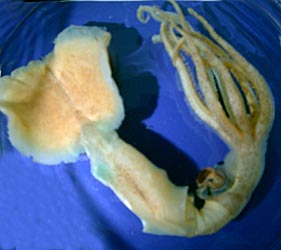
Asperoteuthis mangoldae, previously known as Asperoteuthis sp. A, is a chiroteuthid squid known only from the waters off the Hawaiian Islands. It differs from the closely related Asperoteuthis acanthoderma in lacking integumental tubercles and elongate fins. This species also possesses a characteristic curved groove in its funnel locking apparatus.

Alloteuthis subulata, the European common squid, is a species of squid in the family Loliginidae.
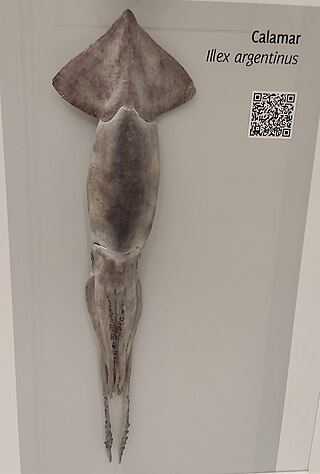
Illex argentinus, commonly known as the Argentine shortfin squid, is a species of squid in the family Ommastrephidae from the south western Atlantic Ocean.

Illex, commonly known as shortfin squids, is a squid genus in the family Ommastrephidae and the only member of the subfamily Illicinae. It contains four species:
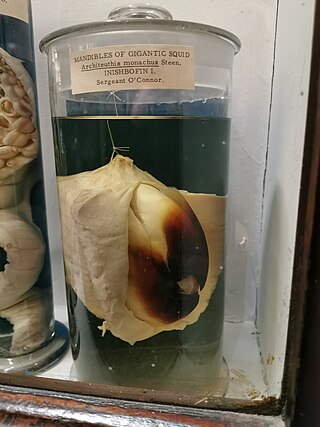
All extant cephalopods have a two-part beak, or rostrum, situated in the buccal mass and surrounded by the muscular head appendages. The dorsal (upper) mandible fits into the ventral (lower) mandible and together they function in a scissor-like fashion. The beak may also be referred to as the mandibles or jaws. These beaks are different from bird beaks because they crush bone while most bird beaks do not.

Illex coindetii, commonly known as the southern shortfin squid or broadtail shortfin squid, is a species of neritic squids in the family Ommastrephidae. They are found in the Mediterranean Sea and on both sides of the north Atlantic Ocean.

Teuthowenia megalops, sometimes known as the Atlantic cranch squid, is a species of glass squid from the subarctic and temperate waters of the northern Atlantic Ocean. They are moderately sized squid with a maximum mantle length of 40 cm (16 in). Their very large eyes are the source for the specific name megalops. Like other members of the genus Teuthowenia, they are easily recognizable by the presence of three bioluminescent organs (photophores) on their eyeballs.

Illex illecebrosus, commonly known as the northern shortfin squid, is a species of neritic squids in the family Ommastrephidae. Squids of the genus Illex account for 65% of the world's cephalopod captures. Illex is formed by four taxa distributed throughout the Atlantic Ocean, whose identification and phylogenetic relationships based on morphological characters remain controversial.They are found in the northwest Atlantic Ocean, from off the coast of eastern North America to Greenland, Iceland, and west of Ireland and the United Kingdom. They are a highly migratory and short-lived species, with lifespans of less than a year. They are commercially important and are fished extensively, mostly for the Canadian and Japanese markets.

Cephalopod fins, sometimes known as wings, are paired flap-like locomotory appendages. They are found in ten-limbed cephalopods as well as in the eight-limbed cirrate octopuses and vampire squid. Many extinct cephalopod groups also possessed fins. Nautiluses and the more familiar incirrate octopuses lack swimming fins. An extreme development of the cephalopod fin is seen in the bigfin squid of the family Magnapinnidae.

Cephalopods exhibit various dermal structures on their mantles and other parts. These may take the form of conspicuous warts, cushions, papillae or scales, though in many species they are microscopic tubercles. The most elaborate forms are found among the oceanic squid of the order Teuthida.

Opisthoteuthis is a genus of cirrate octopuses, sometimes known as flapjack octopuses, which are found in all the world's oceans.
Richard E. Young is a teuthologist. He is an Emeritus Professor of Oceanography at the University of Hawaii's School of Ocean and Earth Science and Technology.
Grimpoteuthis challengeri is a species of large octopus living in the abyssal zone.
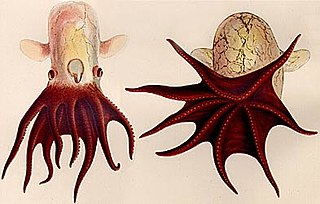
Grimpoteuthis hippocrepium is a species of octopus. It is only known from one specimen found in 1904, which was poorly preserved. Some characteristics G. hippocrepium are unknown.
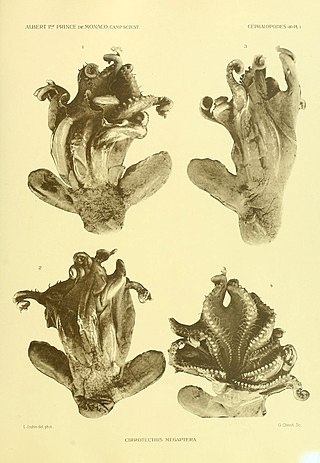
Grimpoteuthis megaptera is a species of octopus known from five specimens, collected by Addison Emery Verrill. Between two and three of these specimens may belong to different species.
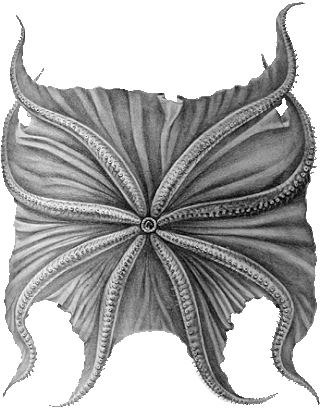
Grimpoteuthis pacifica is an octopus known from one badly damaged specimen. It is not completely described, and it is not easily separated from some other species of octopus. Nothing clearly differentiates G. pacifica from Grimpoteuthis hippocrepium except for its type locality.
Grimpoteuthis tuftsi is an octopus known from seven specimens.

















